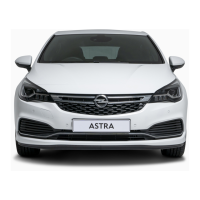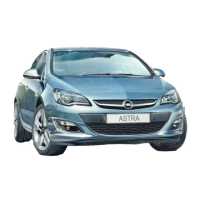Do you have a question about the Opel 2011 Astra J and is the answer not in the manual?
Enter your vehicle's data on the previous page for easy access. Information is available in Service and Technical data sections.
This manual provides necessary information to drive safely and efficiently. Comply with local laws and regulations.
Use the table of contents, index, and section overviews to locate information. Manual depicts left-hand drive vehicles.
Understand symbols and text markings for hazard identification: Danger (fatal injury), Warning (injury), Caution (damage).
Details on unlocking doors with the remote, opening the tailgate, and adjusting front seats for position, backrest, height, and inclination.
Instructions for adjusting head restraints, seat belts, and interior mirrors, including manual anti-dazzle.
Guidance on adjusting exterior mirrors (convex, electric, folding) and the steering wheel for optimal driving position.
Comprehensive guide to instrument panel components, including lights, air vents, signals, cruise control, and various system controls.
Explains exterior lighting, turn signals, hazard flashers, and headlight operation, including automatic and manual modes.
Instructions for windscreen, headlight, and rear window wipers/washers, including adjustable interval and rain sensor functions.
Details on heated rear window/mirrors and demisting/defrosting functions for clear visibility.
Explanation of manual and automatic transmissions, including selector lever positions and starting off procedures.
Steps for starting the engine, operation of the stop-start system, and proper parking procedures including brake application.
Information on keys, locks, replacement keys, car pass, and radio remote control operation for vehicle access.
Details on the central locking system, memorized settings, and how to unlock doors, load compartment, and fuel flap.
Instructions for locking the vehicle, and opening/closing the tailgate using the remote or interior controls.
Troubleshooting for remote control and central locking faults, plus information on the child lock system.
Guidance on operating the tailgate, vehicle security, anti-theft locking, and activating the anti-theft alarm system.
Instructions for manual and power windows, including safety functions and override procedures for safe operation.
Information on operating the sunroof, sun visors, and related safety warnings for child occupants.
Proper positioning and height adjustment of head restraints for front and rear seats to ensure safety.
Detailed guide on adjusting front seats for optimal position, lumbar support, and thigh support for comfort and safety.
Instructions on correctly fastening seat belts, understanding belt force limiters and pretensioners, and height adjustment.
Explanation of the airbag system, including front, side, and curtain airbags, and their deployment mechanisms.
Procedures for deactivating the front passenger airbag and guidelines for selecting and installing child restraint systems.
Permissible options and locations for fitting child restraint systems based on weight class and airbag status.
Details on the glovebox features, cupholder locations, and proper usage while driving.
Information on front storage compartments, sunglasses storage, and additional cupholders in the rear armrest.
Guidance on utilizing underseat storage, armrest storage, and storage in the rear armrest for practicality.
Exploring front and rear console storage, including removable frames and caution for ash usage.
Instructions for extending, installing, locking, and adapting the rear carrier system for bicycle transport.
Guidelines for folding rear seat backrests, load compartment extension, and securing items using seat belts and guides.
Details on lashing eyes, cargo management system components like adapters, mesh pockets, and hooks for securing loads.
Best practices for loading the vehicle compartment, securing objects, and managing weight distribution for safe transport.
Information on steering wheel adjustment and operating infotainment, cruise control, and mobile phones via steering wheel controls.
Guidance on activating the heated steering wheel and using the vehicle horn for signaling.
Detailed instructions for windscreen wiper operation, adjustable interval, automatic wiping with rain sensor, and washer functions.
Adjusting rain sensor sensitivity and operating windscreen and headlight washers for optimal visibility.
Operation of the rear window wiper/washer and display of outside temperature with icy condition warnings.
Setting date and time, understanding clock display, and interpreting ice warning indicators for road safety.
Information on 12-volt power outlets in the front and rear consoles, and the cigarette lighter function.
Explanation of speedometer, odometer, trip odometer, tachometer, fuel gauge, and engine coolant temperature gauge.
Understanding the service display for engine oil life, maintenance reminders, and how to reset the system.
Guide to understanding various control indicators in the instrument cluster and their meanings based on color and illumination.
Explanation of center console indicators for turn signals, seat belt reminders, and airbag/belt tensioner status.
Interpretation of warning lights for charging system, malfunction indicator, service vehicle soon, and brake/clutch fluid level.
Understanding indicators for electrical parking brake, brake assist, hill start assist, and traction control systems.
Information on Electronic Stability Control (ESC), Traction Control (TC) deactivation, and interactive driving modes (SPORT, TOUR).
How to activate, set, increase/reduce speed, and deactivate cruise control for maintaining speed.
Information on Driver Information Center, selecting menus, and vehicle data recording for system status and messages.
Details on vehicle messages, their display on Midlevel and Uplevel screens, and troubleshooting common codes.
How the traffic sign assistant detects and displays speed limits and no-passing signs, with caution notes.
Operating the pop-up function for traffic signs, deactivating it, and addressing system faults and battery voltage issues.
Operation of the light switch, including automatic light control, sidelights, headlights, and tail lights.
Details on automatic light control, daytime running lights, automatic headlight activation, and tunnel detection.
Guidance on using high beams, headlight flash, and manual adjustment of headlight range for optimal visibility.
Explanation of Xenon headlights, adaptive forward lighting functions like curve lighting and corner lighting.
Description of playstreet, town, country, motorway, and adverse weather lighting modes for various driving conditions.
Instructions on using turn signals, hazard warning flashers, and understanding faults in the adaptive forward lighting system.
Operation of front fog lights, rear fog lights, and parking lights for visibility and safety.
Details on reversing lights, misted light covers, and adjusting interior lighting brightness via the instrument panel control.
Information on welcome lighting, centre console lighting, and battery discharge protection measures.
Overview of climate control system functions, including temperature, air distribution, fan speed, and demisting.
Details on the air conditioning system for cooling, dehumidifying, air recirculation, and maximum cooling settings.
Steps for efficient demisting and defrosting of windows using climate control features and heated rear window.
Explanation of automatic mode, temperature preselection, and manual adjustments for maximum comfort.
Guidance on manual climate control settings for fan speed, air distribution, cooling, and air recirculation modes.
Information on the auxiliary heater (Quickheat) and adjustable air vents for directing airflow.
Details on air intake maintenance, pollen filter function, fixed air vents, and comfort mode operation.
Essential driving hints, including not coasting with the engine off and understanding idle boost.
Procedures for new vehicle running-in, ignition switch positions, retained power off functions, and starting the engine.
Guidance on starting the engine at low temperatures, possible non-starting reasons, and turbo engine warm-up.
Explanation of the stop-start system's purpose, activation, deactivation, and autostop procedures.
Detailed conditions that enable autostop and automatic engine restarts, including battery discharge protection.
Safety information on engine exhaust gases and the function and cleaning process of the diesel particle filter.
Information on the catalytic converter's function and cautions regarding fuel types and quality.
Details on automatic transmission operation, transmission display, selector lever positions, and parking.
Instructions for manual transmission gear selection, engine braking, rocking the vehicle, and manual mode operation.
How to use cruise control to store, maintain, and adjust vehicle speed, including activation and deactivation.
Guidance on using the parking assist system, activation, deactivation, fault detection, and important usage hints.
Explanation of the lane departure warning system's function, criteria for detection, activation, and deactivation.
Recommendations for fuel types (petrol and diesel), refuelling safety, and fuel filler flap operation.
General towing information, driving characteristics, trailer loads, coupling load, rear axle load, and towing hitch dimensions.
Recommendations for using genuine parts, vehicle modifications, and proper procedures for long-term vehicle storage.
Performing essential vehicle checks, safety warnings for ignition systems, and how to open the bonnet.
Instructions for checking engine oil level, recommended fluids, and engine coolant, including safety precautions.
Guidance on filling washer fluid, checking brake fluid level, and safety warnings related to brake fluid.
Information on vehicle battery maintenance, replacement procedures, and precautions for vehicles with stop-start systems.
Step-by-step instructions for replacing wiper blades on the windscreen and rear window.
Detailed guide on replacing halogen headlight bulbs, fog lights, and safety warnings for Xenon headlights.
Instructions for replacing bulbs in tail lights, front turn signals, number plate lights, and interior lighting.
Information on fuses, their locations in different fuse boxes, and how to replace a fuse safely.
Guidance on tyre condition, using winter tyres, tyre chains, and understanding tyre designations.
Instructions for checking and adjusting tyre pressure, understanding the monitoring system, and adaptive threshold functions.
Step-by-step guide on using the tyre repair kit, including compressor operation and sealant application.
Detailed instructions for changing a wheel, including safety precautions, jacking points, and securing the wheel.
Information on spare wheel location, classification as temporary, and securing damaged wheels.
Procedures for jump starting a vehicle with a discharged battery and guidelines for towing the vehicle safely.
Advice on washing, waxing, cleaning exterior lights, locks, and interior upholstery for optimal appearance.
Importance of regular maintenance for economical and safe operation, and availability of detailed service schedules.
Overview of recommended service intervals for European and international markets, based on mileage or time.
Guidance on using tested and approved fluids, lubricants, and parts, including engine oil quality and viscosity grades.
Information on using silicate-free coolant, antifreeze, and high-performance brake fluid, with maintenance recommendations.
Location and importance of the Vehicle Identification Number (VIN) and identification plates for vehicle details.
Detailed engine specifications including displacement, power, torque, fuel type, and octane rating for various models.
Maximum speed specifications for 5-door hatchback and Sports tourer models, in mph and km/h.
Figures for fuel consumption (urban, extra-urban, total) and CO2 emissions for different engine and transmission types.
Kerb weight data for 5-door hatchback and Sports tourer models, with and without air conditioning.
Key vehicle dimensions (length, width, height) and capacities, including engine oil volume.
Recommended tyre pressures for different load conditions, engines, and tyre sizes, including ECO settings.
Technical drawings and dimensions for the installation of towing hitches.
Information on vehicle data recording systems (EDR), data storage during operation and crashes, and privacy policies.
Explanation of RFID technology used for vehicle functions like tyre pressure monitoring and ignition security, emphasizing privacy.
Enter your vehicle's data on the previous page for easy access. Information is available in Service and Technical data sections.
This manual provides necessary information to drive safely and efficiently. Comply with local laws and regulations.
Use the table of contents, index, and section overviews to locate information. Manual depicts left-hand drive vehicles.
Understand symbols and text markings for hazard identification: Danger (fatal injury), Warning (injury), Caution (damage).
Details on unlocking doors with the remote, opening the tailgate, and adjusting front seats for position, backrest, height, and inclination.
Instructions for adjusting head restraints, seat belts, and interior mirrors, including manual anti-dazzle.
Guidance on adjusting exterior mirrors (convex, electric, folding) and the steering wheel for optimal driving position.
Comprehensive guide to instrument panel components, including lights, air vents, signals, cruise control, and various system controls.
Explains exterior lighting, turn signals, hazard flashers, and headlight operation, including automatic and manual modes.
Instructions for windscreen, headlight, and rear window wipers/washers, including adjustable interval and rain sensor functions.
Details on heated rear window/mirrors and demisting/defrosting functions for clear visibility.
Explanation of manual and automatic transmissions, including selector lever positions and starting off procedures.
Steps for starting the engine, operation of the stop-start system, and proper parking procedures including brake application.
Information on keys, locks, replacement keys, car pass, and radio remote control operation for vehicle access.
Details on the central locking system, memorized settings, and how to unlock doors, load compartment, and fuel flap.
Instructions for locking the vehicle, and opening/closing the tailgate using the remote or interior controls.
Troubleshooting for remote control and central locking faults, plus information on the child lock system.
Guidance on operating the tailgate, vehicle security, anti-theft locking, and activating the anti-theft alarm system.
Instructions for manual and power windows, including safety functions and override procedures for safe operation.
Information on operating the sunroof, sun visors, and related safety warnings for child occupants.
Proper positioning and height adjustment of head restraints for front and rear seats to ensure safety.
Detailed guide on adjusting front seats for optimal position, lumbar support, and thigh support for comfort and safety.
Instructions on correctly fastening seat belts, understanding belt force limiters and pretensioners, and height adjustment.
Explanation of the airbag system, including front, side, and curtain airbags, and their deployment mechanisms.
Procedures for deactivating the front passenger airbag and guidelines for selecting and installing child restraint systems.
Permissible options and locations for fitting child restraint systems based on weight class and airbag status.
Details on the glovebox features, cupholder locations, and proper usage while driving.
Information on front storage compartments, sunglasses storage, and additional cupholders in the rear armrest.
Guidance on utilizing underseat storage, armrest storage, and storage in the rear armrest for practicality.
Exploring front and rear console storage, including removable frames and caution for ash usage.
Instructions for extending, installing, locking, and adapting the rear carrier system for bicycle transport.
Guidelines for folding rear seat backrests, load compartment extension, and securing items using seat belts and guides.
Details on lashing eyes, cargo management system components like adapters, mesh pockets, and hooks for securing loads.
Best practices for loading the vehicle compartment, securing objects, and managing weight distribution for safe transport.
Information on steering wheel adjustment and operating infotainment, cruise control, and mobile phones via steering wheel controls.
Guidance on activating the heated steering wheel and using the vehicle horn for signaling.
Detailed instructions for windscreen wiper operation, adjustable interval, automatic wiping with rain sensor, and washer functions.
Adjusting rain sensor sensitivity and operating windscreen and headlight washers for optimal visibility.
Operation of the rear window wiper/washer and display of outside temperature with icy condition warnings.
Setting date and time, understanding clock display, and interpreting ice warning indicators for road safety.
Information on 12-volt power outlets in the front and rear consoles, and the cigarette lighter function.
Explanation of speedometer, odometer, trip odometer, tachometer, fuel gauge, and engine coolant temperature gauge.
Understanding the service display for engine oil life, maintenance reminders, and how to reset the system.
Guide to understanding various control indicators in the instrument cluster and their meanings based on color and illumination.
Explanation of center console indicators for turn signals, seat belt reminders, and airbag/belt tensioner status.
Interpretation of warning lights for charging system, malfunction indicator, service vehicle soon, and brake/clutch fluid level.
Understanding indicators for electrical parking brake, brake assist, hill start assist, and traction control systems.
Information on Electronic Stability Control (ESC), Traction Control (TC) deactivation, and interactive driving modes (SPORT, TOUR).
How to activate, set, increase/reduce speed, and deactivate cruise control for maintaining speed.
Information on Driver Information Center, selecting menus, and vehicle data recording for system status and messages.
Details on vehicle messages, their display on Midlevel and Uplevel screens, and troubleshooting common codes.
How the traffic sign assistant detects and displays speed limits and no-passing signs, with caution notes.
Operating the pop-up function for traffic signs, deactivating it, and addressing system faults and battery voltage issues.
Operation of the light switch, including automatic light control, sidelights, headlights, and tail lights.
Details on automatic light control, daytime running lights, automatic headlight activation, and tunnel detection.
Guidance on using high beams, headlight flash, and manual adjustment of headlight range for optimal visibility.
Explanation of Xenon headlights, adaptive forward lighting functions like curve lighting and corner lighting.
Description of playstreet, town, country, motorway, and adverse weather lighting modes for various driving conditions.
Instructions on using turn signals, hazard warning flashers, and understanding faults in the adaptive forward lighting system.
Operation of front fog lights, rear fog lights, and parking lights for visibility and safety.
Details on reversing lights, misted light covers, and adjusting interior lighting brightness via the instrument panel control.
Information on welcome lighting, centre console lighting, and battery discharge protection measures.
Overview of climate control system functions, including temperature, air distribution, fan speed, and demisting.
Details on the air conditioning system for cooling, dehumidifying, air recirculation, and maximum cooling settings.
Steps for efficient demisting and defrosting of windows using climate control features and heated rear window.
Explanation of automatic mode, temperature preselection, and manual adjustments for maximum comfort.
Guidance on manual climate control settings for fan speed, air distribution, cooling, and air recirculation modes.
Information on the auxiliary heater (Quickheat) and adjustable air vents for directing airflow.
Details on air intake maintenance, pollen filter function, fixed air vents, and comfort mode operation.
Essential driving hints, including not coasting with the engine off and understanding idle boost.
Procedures for new vehicle running-in, ignition switch positions, retained power off functions, and starting the engine.
Guidance on starting the engine at low temperatures, possible non-starting reasons, and turbo engine warm-up.
Explanation of the stop-start system's purpose, activation, deactivation, and autostop procedures.
Detailed conditions that enable autostop and automatic engine restarts, including battery discharge protection.
Safety information on engine exhaust gases and the function and cleaning process of the diesel particle filter.
Information on the catalytic converter's function and cautions regarding fuel types and quality.
Details on automatic transmission operation, transmission display, selector lever positions, and parking.
Instructions for manual transmission gear selection, engine braking, rocking the vehicle, and manual mode operation.
How to use cruise control to store, maintain, and adjust vehicle speed, including activation and deactivation.
Guidance on using the parking assist system, activation, deactivation, fault detection, and important usage hints.
Explanation of the lane departure warning system's function, criteria for detection, activation, and deactivation.
Recommendations for fuel types (petrol and diesel), refuelling safety, and fuel filler flap operation.
General towing information, driving characteristics, trailer loads, coupling load, rear axle load, and towing hitch dimensions.
Recommendations for using genuine parts, vehicle modifications, and proper procedures for long-term vehicle storage.
Performing essential vehicle checks, safety warnings for ignition systems, and how to open the bonnet.
Instructions for checking engine oil level, recommended fluids, and engine coolant, including safety precautions.
Guidance on filling washer fluid, checking brake fluid level, and safety warnings related to brake fluid.
Information on vehicle battery maintenance, replacement procedures, and precautions for vehicles with stop-start systems.
Step-by-step instructions for replacing wiper blades on the windscreen and rear window.
Detailed guide on replacing halogen headlight bulbs, fog lights, and safety warnings for Xenon headlights.
Instructions for replacing bulbs in tail lights, front turn signals, number plate lights, and interior lighting.
Information on fuses, their locations in different fuse boxes, and how to replace a fuse safely.
Guidance on tyre condition, using winter tyres, tyre chains, and understanding tyre designations.
Instructions for checking and adjusting tyre pressure, understanding the monitoring system, and adaptive threshold functions.
Step-by-step guide on using the tyre repair kit, including compressor operation and sealant application.
Detailed instructions for changing a wheel, including safety precautions, jacking points, and securing the wheel.
Information on spare wheel location, classification as temporary, and securing damaged wheels.
Procedures for jump starting a vehicle with a discharged battery and guidelines for towing the vehicle safely.
Advice on washing, waxing, cleaning exterior lights, locks, and interior upholstery for optimal appearance.
Importance of regular maintenance for economical and safe operation, and availability of detailed service schedules.
Overview of recommended service intervals for European and international markets, based on mileage or time.
Guidance on using tested and approved fluids, lubricants, and parts, including engine oil quality and viscosity grades.
Information on using silicate-free coolant, antifreeze, and high-performance brake fluid, with maintenance recommendations.
Location and importance of the Vehicle Identification Number (VIN) and identification plates for vehicle details.
Detailed engine specifications including displacement, power, torque, fuel type, and octane rating for various models.
Maximum speed specifications for 5-door hatchback and Sports tourer models, in mph and km/h.
Figures for fuel consumption (urban, extra-urban, total) and CO2 emissions for different engine and transmission types.
Kerb weight data for 5-door hatchback and Sports tourer models, with and without air conditioning.
Key vehicle dimensions (length, width, height) and capacities, including engine oil volume.
Recommended tyre pressures for different load conditions, engines, and tyre sizes, including ECO settings.
Technical drawings and dimensions for the installation of towing hitches.
Information on vehicle data recording systems (EDR), data storage during operation and crashes, and privacy policies.
Explanation of RFID technology used for vehicle functions like tyre pressure monitoring and ignition security, emphasizing privacy.
| Brand | Opel |
|---|---|
| Model | 2011 Astra J |
| Category | Automobile |
| Language | English |












